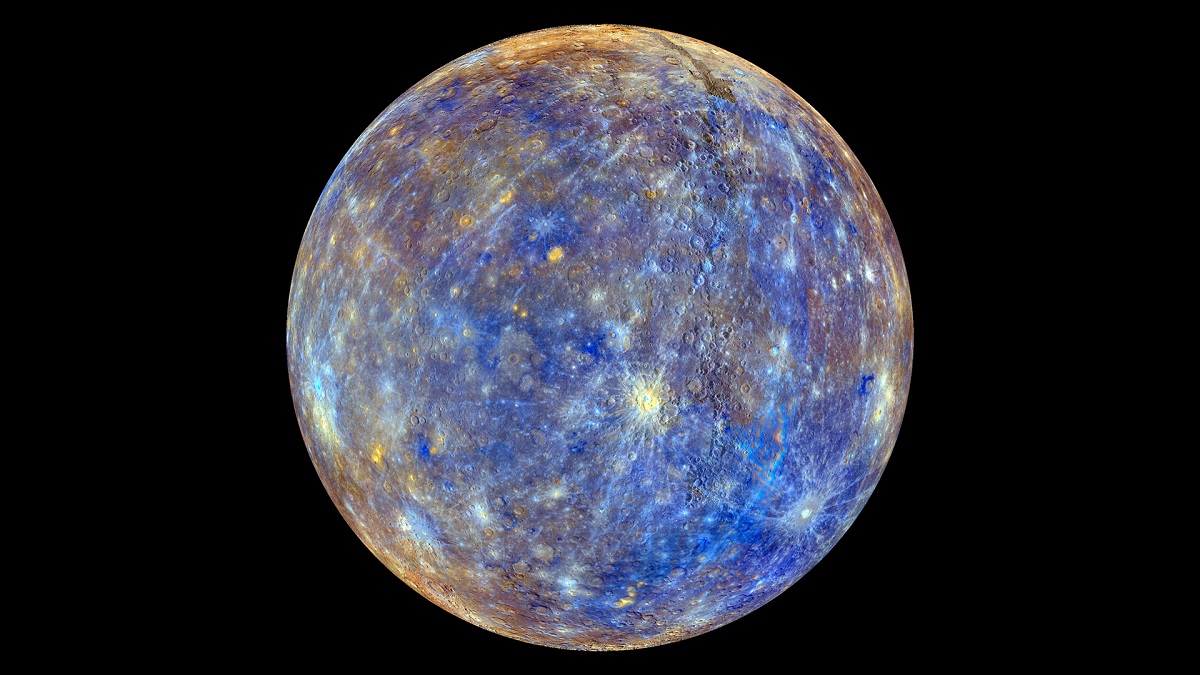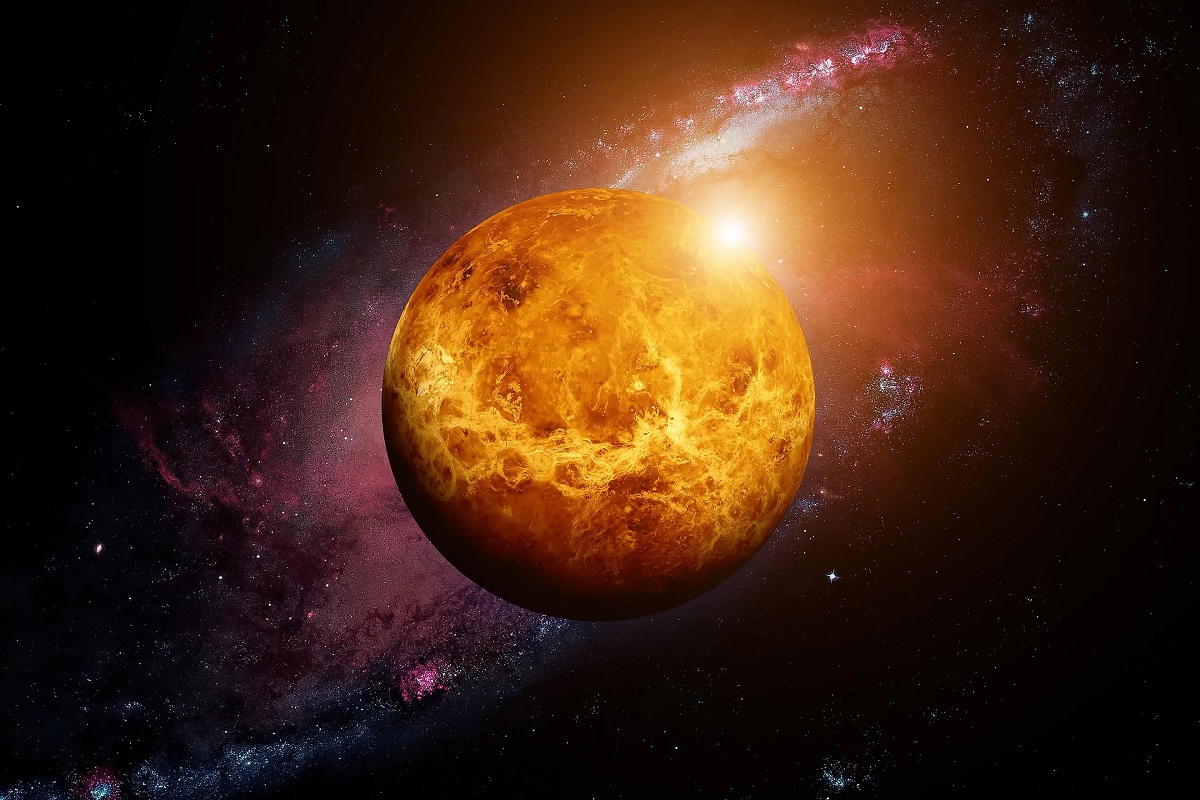Home>Science & Environment>Discover Interesting Facts About Planet Mercury


Science & Environment
Discover Interesting Facts About Planet Mercury
Published: February 19, 2024
Explore fascinating facts about Planet Mercury and its impact on science and the environment. Learn about its unique characteristics and significance in our solar system. Discover more about Mercury's role in shaping our understanding of the universe.
(Many of the links in this article redirect to a specific reviewed product. Your purchase of these products through affiliate links helps to generate commission for Temperatures.com, at no extra cost. Learn more)
Table of Contents
Introduction
Mercury, the smallest and innermost planet in the solar system, is a fascinating celestial body that has captivated the curiosity of scientists and space enthusiasts for centuries. Named after the Roman messenger god, Mercury is a world of extremes, with scorching temperatures, a barren surface, and a lack of substantial atmosphere. Despite its proximity to the Sun, Mercury remains a mysterious and intriguing subject of scientific study.
As the closest planet to the Sun, Mercury orbits at an average distance of about 36 million miles (58 million kilometers) from our star. Due to its proximity, it experiences extreme temperature variations, with surface temperatures soaring to a blistering 800 degrees Fahrenheit (430 degrees Celsius) during the day and plummeting to a bone-chilling -290 degrees Fahrenheit (-180 degrees Celsius) at night. This stark temperature difference is just one of the many unique characteristics that make Mercury a captivating subject of scientific inquiry.
Mercury's enigmatic nature extends beyond its extreme temperatures. Its surface is adorned with a rugged and cratered landscape, reminiscent of the Moon, with vast plains and towering cliffs. Moreover, despite its diminutive size, Mercury possesses a surprisingly strong gravitational pull, which has intrigued scientists for decades.
In this article, we will delve into the captivating world of Mercury, exploring its formation, composition, surface features, atmosphere, orbital characteristics, and the intriguing missions that have sought to unravel its mysteries. Additionally, we will uncover some lesser-known yet captivating facts about this enigmatic planet, shedding light on its unique place in the solar system.
Join us on an exhilarating journey through the cosmos as we unravel the mysteries of Mercury, a world that continues to astound and inspire us with its remarkable characteristics and enigmatic allure.
Formation and Composition
Mercury, like the other terrestrial planets in our solar system, formed approximately 4.5 billion years ago through a process known as accretion. During this tumultuous period of cosmic evolution, countless small particles and rocky debris coalesced under the influence of gravity, gradually giving rise to the rocky worlds that we observe today. As the nascent Sun blazed to life, the swirling disk of dust and gas surrounding it provided the raw materials for the formation of Mercury and its planetary siblings.
Composed primarily of silicate rock and metals, Mercury boasts a dense and compact composition that sets it apart from the other planets in the solar system. Its rocky mantle, which encases a sizable iron core, contributes to its high density and gravitational pull. In fact, Mercury's core accounts for about 60% of its mass, a remarkable feature that distinguishes it as the planet with the largest core relative to its overall size.
The formation of Mercury's dense core is a subject of intense scientific interest and speculation. One prevailing theory suggests that early in its history, Mercury may have experienced a colossal impact with a massive celestial body, resulting in the loss of a significant portion of its outer layers. This cataclysmic event could explain the planet's relatively thin mantle and oversized core, offering a compelling explanation for its unique composition.
Furthermore, Mercury's surface is adorned with an array of elements and compounds, including silicate minerals, sulfur, and traces of other volatile substances. The presence of these materials has piqued the interest of scientists, as they seek to unravel the planet's geological history and the processes that have shaped its rugged terrain over billions of years.
As we continue to unravel the mysteries of Mercury's formation and composition, we gain valuable insights into the dynamic processes that have shaped our solar system. By probing the enigmatic origins of this diminutive world, we inch closer to understanding the cosmic forces that have sculpted the celestial bodies that grace the heavens, offering a glimpse into the awe-inspiring tapestry of the universe.
Surface Features
Mercury's surface is a testament to the tumultuous forces that have shaped it over billions of years. Characterized by a rugged and cratered landscape, it bears the scars of countless cosmic collisions and volcanic upheavals. The planet's surface is divided into two distinct regions: heavily cratered highlands and smooth plains, each offering valuable insights into its geological history.
The heavily cratered highlands, reminiscent of the lunar landscape, are marked by an abundance of impact craters, some of which are remarkably well-preserved. These ancient scars, created by the relentless bombardment of meteoroids and asteroids, provide a window into the early history of the solar system. The sheer density of craters on Mercury's highlands attests to the intensity of the cosmic onslaught that shaped the planet's surface, offering a glimpse into the violent ballet of celestial bodies that unfolded during its formative years.
In stark contrast to the rugged highlands, Mercury's smooth plains, also known as "maria" (Latin for seas), present a strikingly different terrain. These expansive regions, characterized by relatively few impact craters, are believed to have formed through volcanic activity. The lava flows that once surged across these plains, driven by the planet's internal heat, have left behind vast expanses of smooth terrain, creating a captivating juxtaposition with the cratered highlands.
Moreover, Mercury's surface is adorned with towering cliffs and escarpments, some of which stretch for hundreds of miles. These colossal features, known as "lobate scarps," are believed to have formed as the planet's interior cooled and contracted, causing the crust to buckle and fracture. The presence of these enigmatic geological formations has intrigued scientists, offering valuable clues about the planet's tectonic history and the dynamic forces that have shaped its surface.
As we unravel the captivating tapestry of Mercury's surface features, we gain a deeper appreciation for the complex interplay of geological processes that have sculpted this enigmatic world. The planet's rugged terrain, adorned with ancient craters, smooth plains, and towering cliffs, serves as a testament to the enduring forces that have shaped our celestial neighbor, offering a captivating glimpse into the geological history of our solar system.
Atmosphere and Magnetic Field
Mercury's atmosphere is a stark departure from the thick blankets of air that enshroud other planets in the solar system. In fact, the planet's atmosphere is exceedingly tenuous, with a composition that primarily consists of trace amounts of hydrogen, helium, and oxygen. This wispy expanse of gases is a result of several factors, including the planet's proximity to the Sun and its relatively weak gravitational pull, which has allowed the solar wind to strip away much of its original atmosphere over the eons.
Despite its sparse nature, Mercury's atmosphere exhibits intriguing dynamics. The planet's exosphere, the outermost layer of its atmosphere, is subject to the relentless bombardment of solar radiation and charged particles from the Sun. This constant assault has sculpted the exosphere into a dynamic and ever-changing realm, where atoms and molecules are ionized and propelled into space by the solar wind, creating a shimmering halo around the planet.
In addition to its ethereal atmosphere, Mercury boasts a surprisingly robust magnetic field, a feature that sets it apart from other terrestrial planets. This magnetic field, though significantly weaker than Earth's, is thought to be generated by the planet's partially molten iron core. The interaction between this magnetic field and the solar wind creates a complex and dynamic magnetosphere around Mercury, offering valuable insights into the interplay of cosmic forces in the inner solar system.
Moreover, Mercury's magnetic field exhibits peculiar characteristics that have intrigued scientists. Unlike Earth's relatively symmetrical magnetic field, Mercury's field is notably offset from its center, a phenomenon that has puzzled researchers. This enigmatic feature has sparked intense scientific inquiry, as experts seek to unravel the complex processes that govern the planet's magnetic dynamo and the factors that have shaped its distinctive magnetic field.
As we continue to probe the mysteries of Mercury's atmosphere and magnetic field, we gain valuable insights into the dynamic interplay of cosmic forces that have shaped this enigmatic world. The planet's ethereal atmosphere and enigmatic magnetic field offer a captivating window into the intricate dance of celestial phenomena, providing a glimpse into the awe-inspiring tapestry of the cosmos.
Orbital Characteristics
Mercury's orbital characteristics are a testament to the intricate dance of celestial bodies within our solar system. As the closest planet to the Sun, Mercury follows an elliptical orbit, tracing a path that brings it as close as 29 million miles (47 million kilometers) and as far as 43 million miles (70 million kilometers) from our star. This eccentric orbit, coupled with the gravitational influence of the Sun, gives rise to a host of captivating phenomena that set Mercury apart from its planetary counterparts.
One of the most intriguing aspects of Mercury's orbit is its unique resonance with the Sun. Unlike the other planets, Mercury exhibits a peculiar orbital resonance, completing three rotations on its axis for every two orbits around the Sun. This 3:2 spin-orbit resonance is a consequence of the complex gravitational interactions between Mercury, the Sun, and the other planets, leading to a mesmerizing celestial rhythm that has captivated scientists for centuries.
Furthermore, Mercury's proximity to the Sun gives rise to remarkable orbital dynamics. The planet's swift orbital speed, averaging about 29 miles per second (47 kilometers per second), allows it to complete a full orbit in just 88 Earth days. This rapid motion, coupled with its eccentric orbit, results in a captivating celestial ballet, as Mercury hurtles through space, tracing a mesmerizing path around our star.
Moreover, Mercury's orbital characteristics have profound implications for its surface conditions. The planet's proximity to the Sun exposes it to intense solar radiation and tidal forces, contributing to its extreme temperature variations and dynamic geological processes. The relentless gravitational tug of the Sun, coupled with Mercury's eccentric orbit, creates a complex interplay of cosmic forces that have sculpted the planet's enigmatic features over billions of years.
As we unravel the captivating orbital characteristics of Mercury, we gain a deeper appreciation for the intricate celestial dance that shapes our solar system. The planet's elliptical orbit, unique resonance, and swift orbital speed offer a captivating glimpse into the dynamic interplay of cosmic forces that govern its celestial journey, providing valuable insights into the awe-inspiring tapestry of the cosmos.
Read more: Saturn’s Temperature: Facts And Information
Missions to Mercury
Missions to Mercury have played a pivotal role in unraveling the mysteries of this enigmatic planet, offering unprecedented insights into its unique characteristics and dynamic processes. Over the decades, a series of groundbreaking missions have ventured to Mercury, each one contributing to our evolving understanding of this captivating world.
One of the most notable missions to Mercury is NASA's MESSENGER (MErcury Surface, Space ENvironment, GEochemistry, and Ranging) spacecraft, which orbited the planet from 2011 to 2015. Equipped with a suite of advanced instruments, MESSENGER conducted a comprehensive survey of Mercury's surface, composition, magnetic field, and exosphere, shedding light on its geological history and enigmatic features. The spacecraft's observations revealed a wealth of intriguing data, including evidence of volatile compounds on the planet's surface and the presence of water ice in permanently shadowed craters near its poles.
Another pioneering mission to Mercury is the European Space Agency's BepiColombo, a collaborative endeavor with Japan's Aerospace Exploration Agency (JAXA). Launched in 2018, BepiColombo is set to arrive at Mercury in 2025, embarking on a comprehensive study of the planet's surface, interior, and magnetosphere. Equipped with a suite of cutting-edge instruments, including high-resolution cameras and spectrometers, BepiColombo aims to build upon the discoveries of its predecessors, unraveling the remaining enigmas of Mercury's complex geology and magnetic field.
Furthermore, earlier missions such as NASA's Mariner 10, which conducted three flybys of Mercury in the 1970s, paved the way for our initial understanding of the planet's surface and geological features. These early missions laid the foundation for subsequent explorations, inspiring a new era of scientific inquiry into the enigmatic world of Mercury.
As we reflect on the remarkable achievements of these missions, we gain a deeper appreciation for the ingenuity and perseverance of the scientific community in unraveling the mysteries of Mercury. The data and insights garnered from these missions have reshaped our understanding of this captivating planet, offering a tantalizing glimpse into the dynamic forces that have shaped its enigmatic features. With each mission, we inch closer to unlocking the remaining secrets of Mercury, paving the way for future explorations and discoveries that will continue to captivate and inspire us.
Interesting Facts
-
Unusual Spin-Orbit Resonance: Mercury exhibits a unique 3:2 spin-orbit resonance, meaning it rotates three times on its axis for every two orbits around the Sun. This mesmerizing celestial rhythm sets it apart from the other planets in the solar system, showcasing the captivating interplay of gravitational forces that govern its orbital dynamics.
-
Extreme Temperature Variations: With surface temperatures soaring to a blistering 800 degrees Fahrenheit (430 degrees Celsius) during the day and plummeting to a bone-chilling -290 degrees Fahrenheit (-180 degrees Celsius) at night, Mercury experiences the most extreme temperature variations of any planet in our solar system. This stark contrast creates a hostile environment, where the scorching heat of the day gives way to frigid coldness after sunset.
-
Lack of Significant Atmosphere: Mercury's tenuous atmosphere is primarily composed of trace amounts of hydrogen, helium, and oxygen. This wispy expanse of gases is a result of the planet's proximity to the Sun and its weak gravitational pull, which has allowed the solar wind to strip away much of its original atmosphere over the eons.
-
Enigmatic Magnetic Field: Mercury boasts a surprisingly robust magnetic field, generated by its partially molten iron core. Unlike Earth's relatively symmetrical magnetic field, Mercury's field is notably offset from its center, a phenomenon that has puzzled researchers and sparked intense scientific inquiry.
-
Rugged and Cratered Landscape: Mercury's surface is adorned with a rugged and cratered landscape, bearing the scars of countless cosmic collisions and volcanic upheavals. The planet's heavily cratered highlands and smooth plains, reminiscent of the lunar landscape, offer valuable insights into its geological history and the violent cosmic events that have shaped its terrain.
-
Towering Cliffs and Escarpments: The presence of towering cliffs and escarpments, known as "lobate scarps," has intrigued scientists, offering valuable clues about the planet's tectonic history and the dynamic forces that have shaped its surface. These colossal features stretch for hundreds of miles, adding to the enigmatic allure of Mercury's geological features.
-
Water Ice in Permanently Shadowed Craters: Evidence from NASA's MESSENGER mission revealed the presence of water ice in permanently shadowed craters near Mercury's poles, defying expectations for a planet so close to the Sun. This discovery has sparked renewed interest in the planet's polar regions and the potential implications for future exploration and scientific inquiry.
-
Pioneering Space Missions: Groundbreaking missions such as NASA's MESSENGER and the European Space Agency's BepiColombo have played a pivotal role in unraveling the mysteries of Mercury, offering unprecedented insights into its unique characteristics and dynamic processes. These missions have reshaped our understanding of this captivating planet, inspiring a new era of scientific inquiry into the enigmatic world of Mercury.
As we uncover these intriguing facts about Mercury, we gain a deeper appreciation for the enigmatic nature of this diminutive world, offering a tantalizing glimpse into the dynamic forces that have shaped its captivating features.
Conclusion
In conclusion, the enigmatic world of Mercury continues to astound and inspire us with its remarkable characteristics and captivating allure. From its unusual spin-orbit resonance and extreme temperature variations to its rugged and cratered landscape, Mercury stands as a testament to the dynamic forces that have shaped our solar system. The planet's unique composition, tenuous atmosphere, and enigmatic magnetic field offer a captivating window into the intricate dance of celestial phenomena, providing valuable insights into the awe-inspiring tapestry of the cosmos.
As we reflect on the captivating features and intriguing facts about Mercury, we are reminded of the enduring spirit of exploration and discovery that drives humanity's quest to unravel the mysteries of the universe. Pioneering missions such as NASA's MESSENGER and the European Space Agency's BepiColombo have played a pivotal role in shedding light on the planet's enigmatic characteristics, offering unprecedented insights into its unique geology, magnetic field, and orbital dynamics. These missions have reshaped our understanding of Mercury, inspiring a new era of scientific inquiry into this captivating world.
Moreover, the captivating interplay of cosmic forces that govern Mercury's orbital characteristics, surface features, and atmospheric dynamics serves as a testament to the intricate celestial dance that shapes our solar system. The planet's proximity to the Sun, coupled with its unique resonance and swift orbital speed, creates a mesmerizing celestial ballet that continues to captivate scientists and space enthusiasts alike.
As we peer into the enigmatic world of Mercury, we are reminded of the boundless potential for discovery that awaits us beyond the confines of our home planet. The mysteries of Mercury, with its rugged terrain, enigmatic magnetic field, and captivating orbital dynamics, beckon us to delve deeper into the cosmos, inspiring a sense of wonder and curiosity that transcends the boundaries of space and time.
In the grand tapestry of the cosmos, Mercury stands as a testament to the enduring spirit of exploration and the insatiable human desire to unravel the secrets of the universe. As we continue to probe the mysteries of this captivating world, we embark on a journey of discovery and enlightenment, forging new pathways of understanding that will shape our perception of the cosmos for generations to come.










